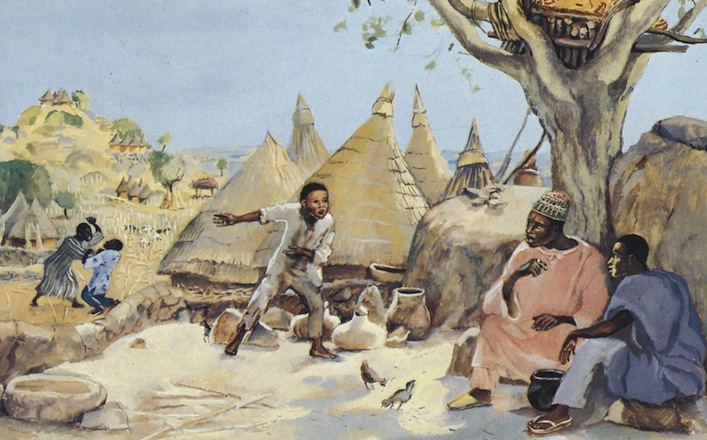Commentary on Exodus 14:19-31
A cloud holds water, promise of rain and sustenance. It presages storm. It can obscure from view the heavens and the workings of God; it can form a barrier in which none can find their way (Exod. 14:19-20).
God is multiply present in this passage. The angel of God walks and the cloud of divine presence stands, first at the head of the camp, then at its vanguard (14:19). Previously their role was to lead. Now their role is to protect and confound.
Throughout this passage the Lord acts and speaks and saves. God again takes up the work of creation, now on behalf of God’s people. But like the cloud, this creative work also has a dark side. Beginning requires ending.
At creation, God’s spirit (ruach), the mighty wind, hovered over the deep (Genesis 1:2). God created light in a place of darkness (1:2-4). God divided water from water (1:6-7), assigning each its place. God gathered together the waters of the earth so that dry land might appear; God named them earth and seas (1:9-10). As God leads God’s people from slavery to freedom, God again makes light in darkness and, by a fierce wind or spirit (ruach), rearranges sea, reveals land, and divides waters (Exodus 14:20-21).
Exodus, the road out from slavery to freedom, is a new creation. God’s power to create from nothing, from formlessness and void, is the same power by which God saves and transforms. It reveals a path for God’s people and builds walls to protect them from the chaos and death of the sea (14:22).
Yet the crossing remains treacherous. Though there is light in this new creation, there is also darkness (14:20). This passage portrays slavery’s end in vivid, violent detail. Chariots, technologies of conquest and visible signs of royal power and status, become a trap for Pharaoh and his armies.
When God rearranges sea and land, the Egyptians think to pursue their former slaves (14:23), but as they enter between the walls of water the gaze of God creates panic among them (14:24), their chariot wheels turn out, and they cannot retreat (14:25). At dawn, the waters return, and as the Egyptians flee, God hurls them into the water (14:27-28). When the Israelites have crossed to safety, they see the bodies of their former masters cast up dead upon the shore (14:30).
I will not justify or mitigate the violence of Pharaoh’s destruction or of the deaths of his soldiers and horses. I do not wish to defend or explain the hardening of Pharaoh’s heart that led him to choose pursuit (14:4-5). This part of the story is hard to hear and hard to preach.
But it foregrounds the consequence of Pharaoh’s grasping. It shows the end result of an economy built on forced labor, exploitation, and domination. In refusing to let God’s people go, Pharaoh leads his own people to their grave. The gaze of God undoes his vision of mastery; the waters of new creation dismantle his chariots and drown the machinery of war and abduction.
There are two words for “dry land” used in this passage. One is yabbashah. This word is most often used in descriptions of the miracle God performed at the Red Sea (6 out of 14 occurrences: Exodus 14:16.22.29, 15:19; Psalm 66:6; Nehemiah 9:11). It also describes God’s work in creation (Genesis 1:9-10, Jonah 1:9) and the people’s miraculous crossing of the Jordan River when they enter the land of promise (Joshus 4:22).
But another word for dry land also appears in the story of the Red Sea crossing (Exodus 14:21). That word, charabah, derives from a root ch–r-b, meaning to dry up or be in ruins. That is, it does not only distinguish between liquid and solid, water and its absence, a place to swim and a place to walk. Forms from this root frequently name the waste and desolation that follows upon warfare, judgment, and destruction. The use of this synonym in verse 21 links the motif of new creation with the end of an order.
Martin Luther King, Jr. called this end “the Death of Evil upon the Seashore.” In his sermon by this title, first preached in 1954, King called out the evils any could see in his own time.1 They included greed and war, “high places where [people] are willing to sacrifice truth on the altars of their self-interest,” and “imperialistic nations trampling over other nations with the iron feet of oppression.”2 King names nations and numbers. And he narrates racial desegregation as God’s work of ending and reordering in his own day: he saw the Red Sea open in the U.S. Supreme Court’s landmark decision in Brown v. Board of Education.
Our world has changed and not changed in the sixty years since King first preached this sermon. What shape does slavery take today? What is the machinery of oppression, domination, exploitation, and new colonialism that must be dismantled so that God’s people may all truly be free? Can you pierce through the cloud and gaze upon the shore to discern and preach the work that God is doing to bring these to an end?
In your preaching, show your congregation the dry land they are walking on. Show them what place it has in God’s creation. Show them the signs of ruin and devastation. Caution them if it will soon revert to sea. Help them see the bodies on the shore, because to ignore them is to ignore the reality of death and the limits of greed, exploitation, and empire. And as they look, help them to see clearly enough that their fear gives way to faith (14:31).
Notes:
1 King published an edited version of this sermon in Martin Luther King, Jr. Strength to Love (New York: Harper & Row, 1963).
2 These quotations are reproduced from the version printed in The Papers of Martin Luther King, Jr., vol. VI: Advocate of the Social Gospel, edited by Clayborn Carson (Berkeley: University of California Press, 2007), p. 505.


September 14, 2014